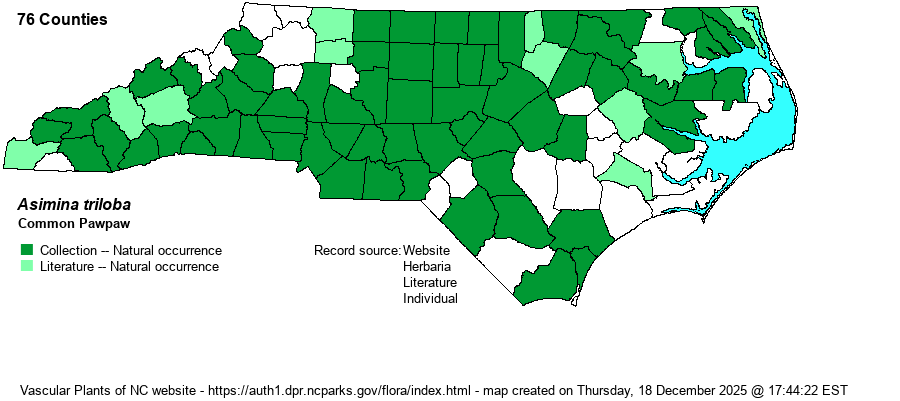| Author | (L.) Dunal | |
| Distribution | Occurs throughout the Piedmont, except seemingly absent in the extreme northwestern corner. Found over most of the Coastal Plain, but absent from the Sandhills proper, of spotty occurrence in the lower third of the province, and probably absent from some coastal counties, especially on the Pamlimarle Peninsula. Found scattered over the central and southern Mountains but is apparently absent from the northern counties along the VA border.
This is an Eastern species, occurring from NJ, western NY, and southern Ont. south to eastern KS, eastern TX, and northwestern FL.
| |
| Abundance | Common in the eastern and southern Piedmont, and in much of the western Coastal Plain, particularly along brownwater rivers. Infrequent or uncommon in much of the Coastal Plain away from such brownwater rivers, except quite common around Lake Phelps in Pettigrew State Park. Infrequent to locally fairly common in the lower Mountains. Its seeming absence in the northwestern part of the state is puzzling, as it occurs across all of WV and KY and nearly all of VA as well. | |
| Habitat | This species occurs in bottomland forests and other rich soils of hardwood forests on floodplains, such as along natural levees and riverbanks. It does occur on lower or mid-slopes of rich hardwood forests, where the soil is circumneutral or basic. |
| Phenology | Blooms from March to May, before the leaves emerge. Fruits from August to October. The large fruit (like small bananas) are usually gathered first by animals, and thus they are not often seen by humans. | |
| Identification | This is a well-known small deciduous tree that grows to about 30 feet tall, frequently in sizable colonies or stands. It can be easily identified in spring when its relatively large, purple-brown, dangling flowers (to 1-1.5 inches across) are seen on the bare branches. The dark purple-brown twigs are also distinctive, with the long and naked terminal buds. When it leaf, it has one of the longest simple leaves of any tree, with the oblanceolate leaves often being 8-10 inches long. | |
| Taxonomic Comments | None
| |
| Other Common Name(s) | Tall Pawpaw, Indian-banana, Papaw. Many references simply call this species as “Pawpaw”. Most people understand that this single word name applies to the tree and not to the low shrub (A. parviflora). However, in NC there is a second pawpaw species. Thus, to be correct, A. triloba should have a modifier in our state, and Common Pawpaw is most often used. | |
| State Rank | S5 | |
| Global Rank | G5 | |
| State Status | | |
| US Status | | |
| USACE-agcp | FAC link |
| USACE-emp | FAC link |

